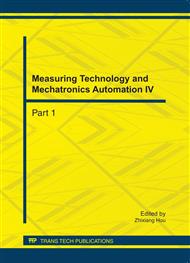p.706
p.710
p.714
p.718
p.727
p.731
p.735
p.741
p.745
The Route Algorithm of Post-Disaster Road Monitoring System
Abstract:
The post-disaster road monitoring system provides an interesting application area for wireless sensor networks. After the earthquake, roads are subject to be blocked by landslides. The people require a scalable and low-cost technology for getting real-time dynamic data about road available because aftershocks occur continuously. Wireless sensor networks are a promising candidate to fulfill these requirements. Then the post-disaster road monitoring system solution is put forward. In this system, the ordered arrangement of node number greatly reduces the complexity of node location and provides the premise and guarantee for designing efficient route algorithm for the system. The algorithms of route established and route forwarding are designed for the arrangement and transmission characteristics of nodes, then are more efficient than general-purpose route protocol.
Info:
Periodical:
Pages:
727-730
Citation:
Online since:
October 2011
Authors:
Price:
Сopyright:
© 2012 Trans Tech Publications Ltd. All Rights Reserved
Share:
Citation:


